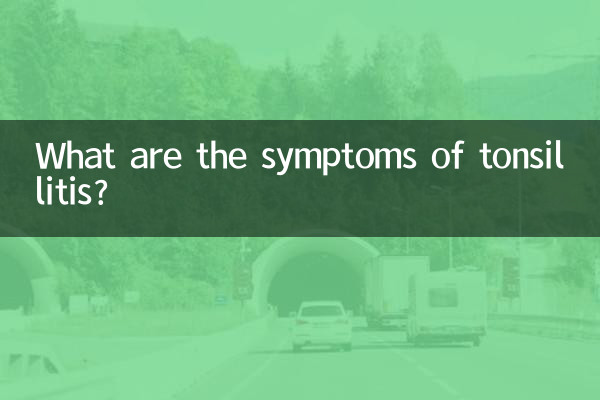What are the symptoms of tonsillitis?
Tonsillitis is a common upper respiratory tract infection, which is more likely to occur during seasonal changes or when immunity is weakened. Recently, there has been a lot of discussion on the Internet about the symptoms and treatment of tonsil inflammation, with many netizens sharing their own experiences and doctors’ advice. The following is a detailed analysis of the symptoms, causes and treatment of tonsil inflammation.
1. Common symptoms of tonsillitis

Symptoms of tonsillitis vary from person to person, but usually include the following:
| symptom | Specific performance |
|---|---|
| sore throat | The pain worsens when swallowing, and in severe cases it may even affect eating and speaking. |
| fever | An increase in body temperature may be accompanied by chills or general weakness. |
| Red and swollen tonsils | The tonsils are significantly enlarged, and white or yellow pus spots may appear on the surface. |
| swollen lymph nodes | The lymph nodes in the neck may be swollen and tender. |
| Cough or hoarseness | Inflammation may spread to the throat, causing coughing or voice changes. |
| Headache or general discomfort | Some patients experience headaches, muscle aches, or fatigue. |
2. Causes of tonsillitis
Tonsillitis is usually caused by a viral or bacterial infection. Here are some common causes:
| Cause type | Specific instructions |
|---|---|
| viral infection | Such as influenza virus, adenovirus, etc., account for the majority of tonsillitis. |
| bacterial infection | Mainly streptococcal infection, which may cause more severe symptoms. |
| Decreased immunity | Infections are more likely to occur when you are tired, stressed, or malnourished. |
| environmental factors | Dry air, dusty air, or cold weather can trigger inflammation. |
3. Treatment of tonsillitis
Treatments vary depending on the cause and severity of symptoms:
| Treatment | Specific measures |
|---|---|
| General treatment | Get plenty of rest, drink plenty of fluids, and avoid spicy and irritating foods. |
| drug treatment | Viral infections usually require symptomatic treatment, such as antipyretics or analgesics; bacterial infections require antibiotics. |
| home care | Rinse your mouth with warm salt water and take throat lozenges to relieve symptoms. |
| surgical treatment | For recurring chronic tonsillitis, surgical removal may be necessary. |
4. How to prevent tonsil inflammation
The key to preventing tonsil inflammation is to strengthen your immunity and avoid sources of infection:
| Precautions | Specific methods |
|---|---|
| Maintain oral hygiene | Brush your teeth and rinse your mouth frequently to avoid bacterial growth. |
| Enhance immunity | Eat a balanced diet, exercise moderately, and get enough sleep. |
| Avoid contact with infected people | Reduce close contact with people who have a cold or strep throat. |
| Keep warm | When seasons change, add or remove clothing in time to avoid catching cold. |
5. Discussions with netizens on recent hot topics
In the past 10 days, hot topics about tonsil inflammation have mainly focused on the following aspects:
1."Should tonsillitis be removed?": Many netizens have shared their own experiences of recurring attacks. Some people believe that the quality of life has improved after resection, but others are worried about the risks of surgery.
2."What medicine should I take for tonsillitis?": Doctors recommend distinguishing between viral and bacterial infections to avoid overuse of antibiotics.
3."How to care for tonsillitis in children?": Parents are concerned about how to relieve their children's pain and fever, especially when symptoms worsen at night.
4.“The Difference Between Tonsillitis and COVID-19”: Some netizens confuse the early symptoms of tonsillitis and new coronavirus infection, and experts remind them to distinguish between them.
Although tonsil inflammation is common, it is important to recognize the symptoms promptly and take the correct treatment. If symptoms continue to worsen or recur, it is recommended to seek medical treatment as soon as possible to avoid complications.

check the details

check the details